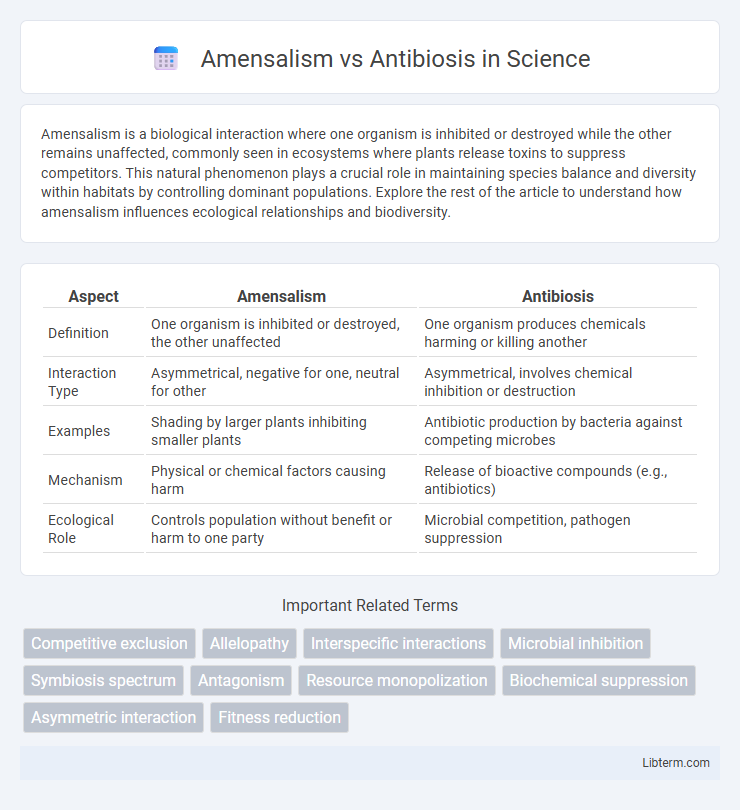Amensalism is a biological interaction where one organism is inhibited or destroyed while the other remains unaffected, commonly seen in ecosystems where plants release toxins to suppress competitors. This natural phenomenon plays a crucial role in maintaining species balance and diversity within habitats by controlling dominant populations. Explore the rest of the article to understand how amensalism influences ecological relationships and biodiversity.
Table of Comparison
| Aspect | Amensalism | Antibiosis |
|---|---|---|
| Definition | One organism is inhibited or destroyed, the other unaffected | One organism produces chemicals harming or killing another |
| Interaction Type | Asymmetrical, negative for one, neutral for other | Asymmetrical, involves chemical inhibition or destruction |
| Examples | Shading by larger plants inhibiting smaller plants | Antibiotic production by bacteria against competing microbes |
| Mechanism | Physical or chemical factors causing harm | Release of bioactive compounds (e.g., antibiotics) |
| Ecological Role | Controls population without benefit or harm to one party | Microbial competition, pathogen suppression |
Understanding Amensalism and Antibiosis
Amensalism describes a biological interaction where one organism is inhibited or destroyed while the other remains unaffected, often seen in plant competition through the release of allelopathic chemicals. Antibiosis is a specific type of amensalism involving the production of antibiotics or other biochemicals by one microbe that suppress or kill competing microorganisms. Understanding amensalism and antibiosis reveals key mechanisms in ecological balance and microbial competition, highlighting their roles in shaping community dynamics.
Defining Key Concepts: Amensalism
Amensalism is a biological interaction where one organism is inhibited or destroyed while the other remains unaffected, characterized by a unilateral negative effect. This ecological relationship differs from antibiosis, which specifically involves the production of biochemical substances to inhibit or kill other organisms. Understanding amensalism helps in studying species competition and ecosystem dynamics where indirect harm occurs without reciprocal influence.
Antibiosis Explained: Mechanisms and Examples
Antibiosis is a biological interaction where one organism produces substances that inhibit or kill another, benefiting itself without the latter being affected in return. This mechanism often involves the production of antibiotics, enzymes, or toxins that disrupt cellular processes in competing microorganisms, such as the release of penicillin by Penicillium fungi to suppress bacterial growth. Examples include Streptomyces bacteria producing streptomycin to inhibit other bacteria, highlighting antibiosis as a critical factor in natural microbial competition and antibiotic development.
Key Differences Between Amensalism and Antibiosis
Amensalism involves one organism being inhibited or destroyed while the other remains unaffected, exemplified by a tree shading smaller plants. Antibiosis specifically refers to the harmful effect one organism exerts on another through the production of biochemical substances, such as antibiotics secreted by bacteria. The key difference lies in amensalism's passive hindrance without benefit to the inhibitor, whereas antibiosis involves active biochemical interference that can confer a competitive advantage.
Ecological Significance of Amensalism
Amensalism plays a crucial role in regulating population dynamics by inhibiting the growth or survival of one species without benefiting the other, thereby maintaining ecological balance. It often occurs through the production of antimicrobial substances or physical shading, which suppress competing organisms and contribute to biodiversity. This interaction prevents dominance by any single species, fostering coexistence and stabilizing ecosystems.
Role of Antibiosis in Natural Ecosystems
Antibiosis plays a crucial role in natural ecosystems by mediating interactions where one organism produces biochemical compounds that inhibit or kill another, effectively controlling population dynamics and maintaining microbial balance. This antagonistic relationship helps suppress pathogenic microbes, supports nutrient cycling, and promotes biodiversity by limiting the dominance of any single species. In contrast to amensalism, which generally causes harm without benefit, antibiosis involves active biochemical warfare essential for ecosystem health and resilience.
Examples of Amensalism in Nature
Amensalism in nature is exemplified by black walnut trees (Juglans nigra), which release juglone, a chemical that inhibits the growth of nearby plants. Another example includes penicillium mold producing penicillin, which kills sensitive bacteria without benefiting itself. Amensalism differs from antibiosis, where one organism benefits directly by producing harmful substances to inhibit competitors.
Real-World Cases of Antibiosis
Antibiosis is a biological interaction where one organism produces substances that inhibit or kill another, exemplified by the production of antibiotics like penicillin by Penicillium mold affecting bacterial populations. Real-world cases include Streptomyces bacteria synthesizing streptomycin to suppress competing microorganisms in soil ecosystems and Bacillus species producing bacitracin that targets bacterial cell wall synthesis. These naturally occurring antibacterial interactions play a crucial role in controlling microbial communities and have significant applications in medicine and agriculture.
Amensalism and Antibiosis in Microbial Communities
Amensalism in microbial communities refers to the phenomenon where one microorganism inhibits or harms another without benefiting itself, often through the secretion of harmful metabolites or antibiotics. Antibiosis is a specific form of amensalism characterized by the production of bioactive compounds by one microbe that suppress or kill competing microorganisms, playing a crucial role in microbial population dynamics and ecological balance. These interactions regulate microbial diversity and function, influencing soil health, nutrient cycling, and pathogen suppression in various ecosystems.
Implications for Biotechnology and Medicine
Amensalism and antibiosis both describe interactions where one organism inhibits another, but antibiosis specifically involves the production of bioactive compounds such as antibiotics, which have crucial applications in medicine for treating bacterial infections. In biotechnology, antibiosis drives the development of new antimicrobial agents and probiotics by exploiting microbial metabolites that suppress pathogens. Understanding these interactions enhances strategies for disease control, drug discovery, and microbial community management in therapeutic and industrial settings.
Amensalism Infographic

 libterm.com
libterm.com